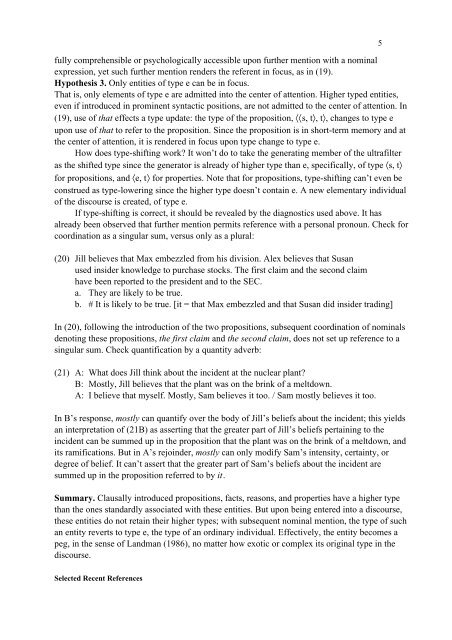SemPrag03.Progr.pdf - Institut für Linguistik/Germanistik - Universität ...
SemPrag03.Progr.pdf - Institut für Linguistik/Germanistik - Universität ...
SemPrag03.Progr.pdf - Institut für Linguistik/Germanistik - Universität ...
You also want an ePaper? Increase the reach of your titles
YUMPU automatically turns print PDFs into web optimized ePapers that Google loves.
fully comprehensible or psychologically accessible upon further mention with a nominal<br />
expression, yet such further mention renders the referent in focus, as in (19).<br />
Hypothesis 3. Only entities of type e can be in focus.<br />
That is, only elements of type e are admitted into the center of attention. Higher typed entities,<br />
even if introduced in prominent syntactic positions, are not admitted to the center of attention. In<br />
(19), use of that effects a type update: the type of the proposition, 〈〈s, t〉, t〉, changes to type e<br />
upon use of that to refer to the proposition. Since the proposition is in short-term memory and at<br />
the center of attention, it is rendered in focus upon type change to type e.<br />
How does type-shifting work? It won’t do to take the generating member of the ultrafilter<br />
as the shifted type since the generator is already of higher type than e, specifically, of type 〈s, t〉<br />
for propositions, and 〈e, t〉 for properties. Note that for propositions, type-shifting can’t even be<br />
construed as type-lowering since the higher type doesn’t contain e. A new elementary individual<br />
of the discourse is created, of type e.<br />
If type-shifting is correct, it should be revealed by the diagnostics used above. It has<br />
already been observed that further mention permits reference with a personal pronoun. Check for<br />
coordination as a singular sum, versus only as a plural:<br />
(20) Jill believes that Max embezzled from his division. Alex believes that Susan<br />
used insider knowledge to purchase stocks. The first claim and the second claim<br />
have been reported to the president and to the SEC.<br />
a. They are likely to be true.<br />
b. # It is likely to be true. [it = that Max embezzled and that Susan did insider trading]<br />
In (20), following the introduction of the two propositions, subsequent coordination of nominals<br />
denoting these propositions, the first claim and the second claim, does not set up reference to a<br />
singular sum. Check quantification by a quantity adverb:<br />
(21) A: What does Jill think about the incident at the nuclear plant?<br />
B: Mostly, Jill believes that the plant was on the brink of a meltdown.<br />
A: I believe that myself. Mostly, Sam believes it too. / Sam mostly believes it too.<br />
In B’s response, mostly can quantify over the body of Jill’s beliefs about the incident; this yields<br />
an interpretation of (21B) as asserting that the greater part of Jill’s beliefs pertaining to the<br />
incident can be summed up in the proposition that the plant was on the brink of a meltdown, and<br />
its ramifications. But in A’s rejoinder, mostly can only modify Sam’s intensity, certainty, or<br />
degree of belief. It can’t assert that the greater part of Sam’s beliefs about the incident are<br />
summed up in the proposition referred to by it.<br />
Summary. Clausally introduced propositions, facts, reasons, and properties have a higher type<br />
than the ones standardly associated with these entities. But upon being entered into a discourse,<br />
these entities do not retain their higher types; with subsequent nominal mention, the type of such<br />
an entity reverts to type e, the type of an ordinary individual. Effectively, the entity becomes a<br />
peg, in the sense of Landman (1986), no matter how exotic or complex its original type in the<br />
discourse.<br />
5<br />
Selected Recent References

















